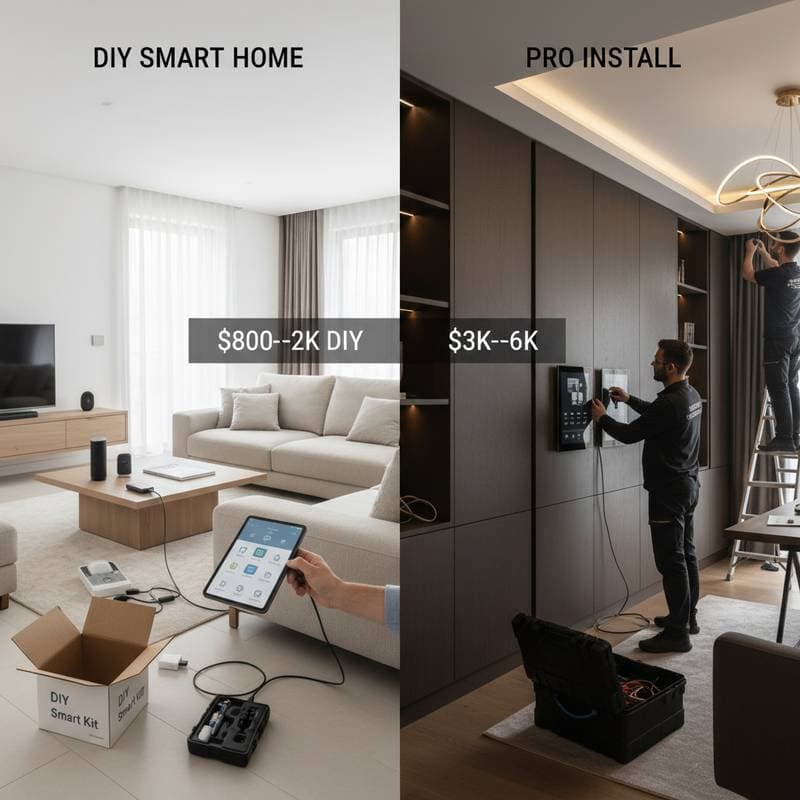Balance Savings and Safety: DIY Smart Home Setup or Professional Installation in 2025
Homeowners often face a straightforward choice when integrating smart technology. Self-installation of devices such as lighting, cameras, thermostats, and plugs offers substantial savings, provided individuals recognize their boundaries. Projects involving wiring modifications or circuit enhancements demand professional expertise to ensure safety and adherence to electrical codes. The optimal approach involves assessing personal skills prior to purchasing equipment.
Essential Cost Breakdown
A full smart home configuration typically spans $800 to $6,000, influenced by the scope of included features. Those opting for DIY methods generally invest $800 to $2,000 in wireless, plug-and-play components and central hubs. Professional services, which encompass wiring integration and electrical panel modifications, elevate expenses to $3,000 to $6,000. This difference reflects not only labor but also comprehensive safety evaluations, warranty assurances, and streamlined issue resolution over time.
Scenarios Ideal for DIY Installation
Projects limited to Wi-Fi-enabled or battery-operated devices suit most homeowners without specialized training. Contemporary smart bulbs, switches, and plugs feature user-friendly designs that prioritize simplicity over complexity.
Popular devices suitable for self-installation include:
- Smart plugs and outlets that attach to standard receptacles
- Wi-Fi-enabled cameras and video doorbells
- Thermostats equipped with straightforward wiring instructions
- Voice-activated LED bulbs or light strips
- Motorized systems for blinds and curtains
These items demand basic tools, a mobile device for setup, and reliable internet connectivity. Most installations require less than one hour per unit. The primary hurdle lies in unifying devices within a single ecosystem, such as Google Home, Amazon Alexa, or Apple HomeKit.
Practical Advice: Establish a consistent labeling protocol during setup. Assign descriptive names to rooms and devices within the application, such as "Kitchen Overhead Light," to simplify future diagnostics and control.
Situations Requiring an Electrician
Electrical wiring or panel adjustments necessitate licensed professionals to mitigate risks. In-wall smart switches, comprehensive lighting networks, or permanently wired security components demand expert intervention.
Specific tasks that warrant professional assistance include:
- Replacement of traditional wall switches with wired smart alternatives
- Creation of dedicated circuits for high-power smart appliances
- Configuration of unified systems, including intelligent panels and energy tracking devices
- Modernization of obsolete breaker panels to accommodate greater electrical demands
- Verification of compliance with regional building regulations
Professionals bill $75 to $150 hourly, with smart home projects spanning four to eight hours based on intricacy. Beyond precise execution, certified electricians guarantee regulatory conformity, which proves vital for insurance coverage and home sales. Non-compliance detected in inspections may negate DIY cost advantages through fines or rework.
Evaluating Return on Investment
Smart home technologies extend beyond mere convenience to deliver tangible benefits in efficiency and market appeal. Programmable thermostats lower energy expenses by as much as 10 percent annually. Automated lighting configurations reduce consumption by at least 5 percent, while advanced security integrations enhance buyer interest during property transactions.
Self-managed setups accelerate financial recovery through eliminated labor fees, yet expert installations promote durability and eligibility for manufacturer warranties that mandate professional certification. For those considering home sales or rentals, certified installation records serve as compelling assets in negotiations.
Prioritizing Safety and Regulatory Adherence
Electrical standards protect against hazards, particularly in endeavors touching breaker panels, conduits, or high-load connections. Faulty installations risk short circuits, frequent breaker activations, or potential fires.
Indicators signaling the need for immediate professional evaluation include:
- Visible sparks or intermittent light fluctuations post-installation
- Devices that lose power connections repeatedly
- Unusual humming from receptacles or switches
- Recurrent breaker trips under normal operation
Upon encountering these issues, cease activities and engage a qualified electrician without delay. Local authorities often mandate permits for substantial electrical alterations; bypassing this process may invalidate insurance policies amid incidents. Request verification of the electrician's credentials and coverage prior to commencement.
Developing a Combined Approach
Homeowners need not commit exclusively to one method. Many achieve economies by managing initial placements independently, followed by professional consolidation into the home's electrical framework. For example, individuals might deploy smart plugs, surveillance cameras, and control hubs personally, then retain an electrician for in-wall switch wiring and supplementary circuits supporting security arrays.
Strategies for Effective Implementation
- Initiate Modestly: Focus on a single area or function, like illumination or temperature regulation, prior to whole-home expansion.
- Record All Aspects: Preserve purchase records, setup documentation, and photographic evidence of wiring configurations to support warranty processes and property transfers.
- Verify Interoperability: Select devices aligned with a unified platform to prevent integration challenges.
- Allocate Reserves Wisely: Reserve 10 to 15 percent of funds for unforeseen equipment or consultations.
- Monitor Advancements: Prioritize ecosystems offering reliable updates for software and security enhancements.
Sustaining Long-Term Performance
After establishing the system, upkeep primarily involves software oversight. Conduct monthly verifications of connectivity, perform functionality tests on linked components, and apply firmware updates promptly. Swap out batteries in sensors and cameras every three to six months, and remove accumulated debris from central units or network extenders to maintain signal integrity.
Equilibrium yields the greatest rewards. Manage feasible elements independently while securing expert aid for critical components. This method delivers reliable operation, hazard prevention, and enduring advantages without excessive expenditure.
